002通过G-四链体、功能化金纳米粒子,可视化检测肌红蛋白的比色生物传感器
金纳米颗粒在核酸检测中的应用

金纳米颗粒在核酸检测中的应用随着科技的不断进步,核酸检测已经成为现代医疗中不可或缺的一部分。
而在众多新型技术中,金纳米颗粒的应用正在逐渐崭露头角,以其独特的优势在核酸检测领域发挥着重要作用。
一、金纳米颗粒的性质金纳米颗粒,顾名思义,是由黄金制成的纳米级别大小的颗粒。
这些颗粒具有优异的物理和化学性质,如稳定性、生物相容性和光热性质等。
在光热性质方面,金纳米颗粒具有显著的光热转换效应,可以在特定波长的光照射下产生热量,这一特性使其在生物医学领域具有广泛的应用前景。
二、金纳米颗粒在核酸检测中的优势1.高灵敏度:金纳米颗粒的信号放大功能使得核酸检测的灵敏度大大提高,能够检测出极低浓度的目标物质。
2.特异性高:通过合理设计金纳米颗粒的形状和尺寸,可以实现对特定核酸序列的高特异性识别,降低假阳性率。
3.操作简便:金纳米颗粒的使用使得核酸检测流程简化,降低了对实验设备和操作技术的要求。
4.实时可视化:利用金纳米颗粒的显色反应,可以直接在试纸上观察到检测结果,无需借助专业仪器。
三、金纳米颗粒在核酸检测中的应用实例1.疾病诊断:通过检测特定疾病相关基因或蛋白质的核酸序列,可以对疾病进行早期诊断和预后评估。
例如,利用金纳米颗粒的核酸扩增技术可以对癌症进行早期检测。
2.病毒检测:在新冠病毒等病毒的核酸检测中,金纳米颗粒技术被广泛应用于实时荧光定量PCR等检测方法中,提高了检测的灵敏度和特异性。
3.食品安全:通过检测食品中的微生物核酸序列,可以判断食品是否受到污染,确保食品安全。
例如,在牛奶中检测大肠杆菌等有害微生物时可以采用金纳米颗粒技术。
4.环境监测:在环境监测领域,金纳米颗粒技术也被用于检测水体中的有害物质和空气中的病毒核酸等。
四、结论与展望金纳米颗粒在核酸检测中的应用具有显著的优势和广泛的前景。
随着研究的深入和技术的发展,金纳米颗粒将在更多领域得到应用,为人类带来更多福祉。
未来,金纳米颗粒技术的发展将更加注重提高灵敏度、特异性和稳定性等方面,同时探索与其他技术的结合,以实现更高效、更准确的检测。
基于G-四链体-氯血红素DNA酶的传感器对血清中甲胎蛋白的检测
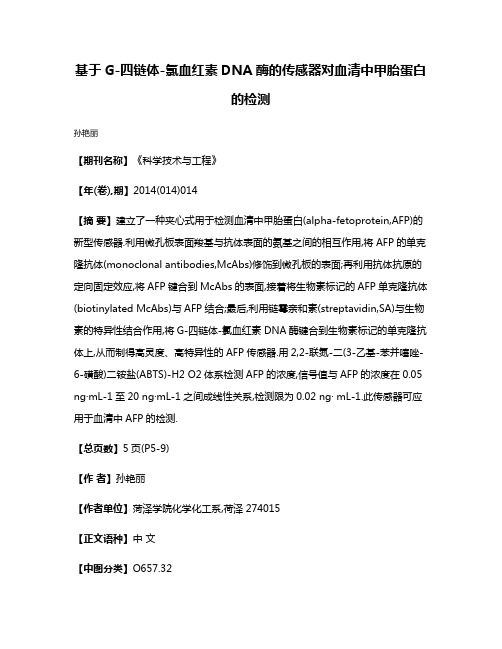
基于G-四链体-氯血红素DNA酶的传感器对血清中甲胎蛋白的检测孙艳丽【期刊名称】《科学技术与工程》【年(卷),期】2014(014)014【摘要】建立了一种夹心式用于检测血清中甲胎蛋白(alpha-fetoprotein,AFP)的新型传感器.利用微孔板表面羧基与抗体表面的氨基之间的相互作用,将AFP的单克隆抗体(monoclonal antibodies,McAbs)修饰到微孔板的表面;再利用抗体抗原的定向固定效应,将AFP键合到McAbs的表面,接着将生物素标记的AFP单克隆抗体(biotinylated McAbs)与AFP结合;最后,利用链霉亲和素(streptavidin,SA)与生物素的特异性结合作用,将G-四链体-氯血红素DNA酶键合到生物素标记的单克隆抗体上,从而制得高灵度、高特异性的AFP传感器.用2,2-联氮-二(3-乙基-苯并噻唑-6-磺酸)二铵盐(ABTS)-H2 O2体系检测AFP的浓度,信号值与AFP的浓度在0.05 ng·mL-1至20 ng·mL-1之间成线性关系,检测限为0.02 ng· mL-1.此传感器可应用于血清中AFP的检测.【总页数】5页(P5-9)【作者】孙艳丽【作者单位】菏泽学院化学化工系,荷泽274015【正文语种】中文【中图分类】O657.32【相关文献】1.基于滚环扩增及串联G-四链体-血红素DNA酶的高灵敏"Turn-on"型Hg2+传感器研究 [J], 张何;王青;傅昕;赵智粮2.基于磁纳米颗粒和分子间裂分G-四链体-血红素DNA酶的Ag+和半胱氨酸传感器研究 [J], 傅昕;顾丹玉;赵圣东;温世彤;张何3.基于分子间裂分G-四链体-氯化血红素DNA酶自组装纳米线的\"Turn-on\"型汞离子传感研究 [J], 张何;赵智粮;傅昕;王青4.基于G-四链体-氯化血红素DNA酶比色法测定银离子和汞离子传感器的构筑[J], 肖志友;司恒丹;邓兰清;龙丽;居荣梅;张鑫;刘益飞5.血红素/G-四链体DNA酶的活性增强研究及其在生物传感器中的应用进展 [J], 莫艳红;李晖;王彬;徐晓慧;刘思思;曾冬冬因版权原因,仅展示原文概要,查看原文内容请购买。
基于G-四链体-血红素和链式放大反应的基因检测传感器的构建
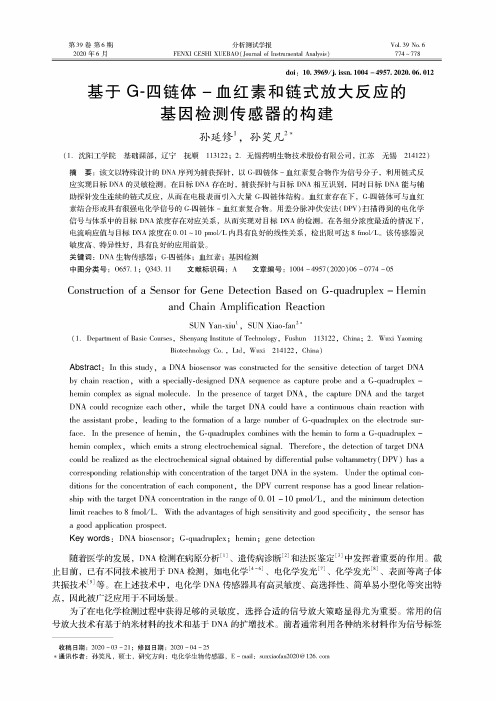
第39卷第9期2026年9月分析测试学报FENXI CESHI XUEBAO(Joxmal of Instrumental Analysis)Vol.39No9774-776doi:10・3969/j.issn.1204-4957.2220.06.012基于G■四链体-血红素和链式放大反应的基因检测传感器的构建孙延修0,孙笑凡2*(1.沈阳工学院基础课部,辽宁抚顺1036; 6.无锡药明生物技术股份有限公司,江苏无锡63126)摘要:该文以特殊设计的DNA序列为捕获探针,以G-四链体-血红素复合物作为信号分子,利用链式反应实现目标DNA的灵敏检测。
在目标DNA存在时,捕获探针与目标DNA相互识别,同时目标DNA能与辅助探针发生连续的链式反应,从而在电极表面引入大量G-四链体结构。
血红素存在下,G-四链体可与血红素结合形成具有很强电化学信号的G四链体-血红素复合物。
用差分脉冲伏安法(DPV)扫描得到的电化学信号与体系中的目标DNA浓度存在对应关系,从而实现对目标DNA的检测。
在各组分浓度最适的情况下,电流响应值与目标DNA浓度在0.01-/pmol/L内具有良好的线性关系,检岀限可达8fmol/To该传感器灵敏度高、特异性好,具有良好的应用前景。
关键词:DNA生物传感器;G-四链体;血红素;基因检测中图分类号:O957.1;Q303.11文献标识码:A文章编号:1004-4957(2222)/6-0774-05ConsWuctmu of a Sensor for Gena Detection Based on G-qnabrupley-Heminand COain AmpliCcotion ReactionSUN Yan-xin1,SUN Xiao-fan2*(1.Departue/t oh Basie Conrscs:Sheoyany Institute oh TecUnologo,Fushun113/6,Chino; 6.Wuxi YaomingBiotecUnologo Co.,Lth,W up-614126,China)AbstfdCt:In this su P o,a DNA biososor was constmcted Ou the sensitive detection of toyO DNA by chain reaction,with a spoiOly四oignO DNA senuenco as capture pmPe and a G-qudOmplo-hemin complee as signal momcute.In the presence of Ui/O DNA,the capture DNA and the Umyt DNA could recognioe each othec,white the toyO DNA could have a continnons chain reaction with the assistant probe-leaping to the fornidtUn of a larae number of G四udOmpmc on the electrobe sua face.In the presence of hemin;the G四PdOmpmc combines with the hemin to fomi a G四udbrupmc-hemin complee-which emits a strong electrochemical sigimb Therefore,the detection of toyO DNA could be realized as the electrochemical signal oPtained1diCerential pulse voltammOry(DPV)has a coiropondVa relationshid with concotmtion of the Ui/O DNA in the system.Undec the optimal com ditions O u the concodtration of each componot:the DPV current response has a goob bnor匸0000四ship with the target DNA concoWOUn in the zange of0.01-10pm(U/L,and the minimum detection limit reaches to5彳。
构建G4-DNAzyme比色生物传感器检测肿瘤标志物miRNA-21的研究
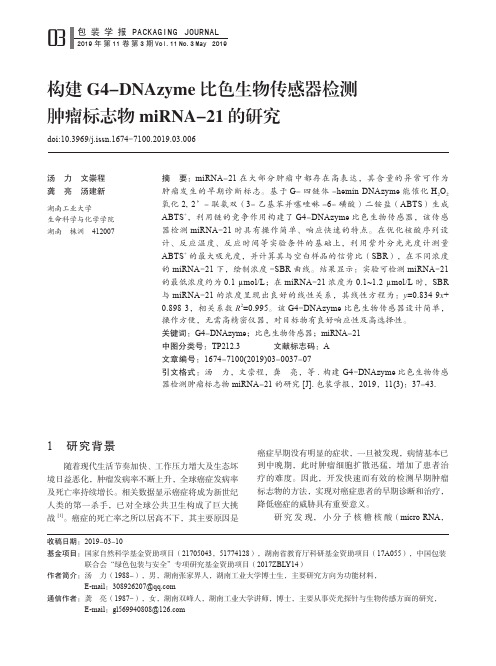
构建 G4-DNAzyme 比色生物传感器检测肿瘤标志物miRNA-21的研究doi:10.3969/j.issn.1674-7100.2019.03.006收稿日期:2019-03-10基金项目:国家自然科学基金资助项目(21705043,51774128),湖南省教育厅科研基金资助项目(17A055),中国包装 联合会“绿色包装与安全”专项研究基金资助项目(2017ZBLY14)作者简介:汤 力(1988-),男,湖南张家界人,湖南工业大学博士生,主要研究方向为功能材料, E-mail :308926207@通信作者:龚 亮(1987-),女,湖南双峰人,湖南工业大学讲师,博士,主要从事荧光探针与生物传感方面的研究, E-mail :gl569940808@汤 力 文崇程龚 亮 汤建新湖南工业大学生命科学与化学学院湖南 株洲 412007摘 要:miRNA -21在大部分肿瘤中都存在高表达,其含量的异常可作为肿瘤发生的早期诊断标志。
基于G -四链体-hemin DNAzyme 能催化H 2O 2氧化2, 2’-联氨双(3-乙基苯并噻唑啉-6-磺酸)二铵盐(ABTS )生成ABTS +,利用链的竞争作用构建了G4-DNAzyme 比色生物传感器,该传感器检测miRNA -21时具有操作简单、响应快速的特点。
在优化核酸序列设计、反应温度、反应时间等实验条件的基础上,利用紫外分光光度计测量ABTS +的最大吸光度,并计算其与空白样品的信背比(SBR ),在不同浓度的miRNA -21下,绘制浓度-SBR 曲线。
结果显示:实验可检测miRNA -21的最低浓度约为0.1 µmol/L ;在miRNA -21浓度为0.1~1.2 µmol/L 时,SBR 与miRNA -21的浓度呈现出良好的线性关系,其线性方程为:y =0.834 9x +0.898 3,相关系数R 2=0.995。
功能化金纳米粒子标记的生物芯片的构建及应用
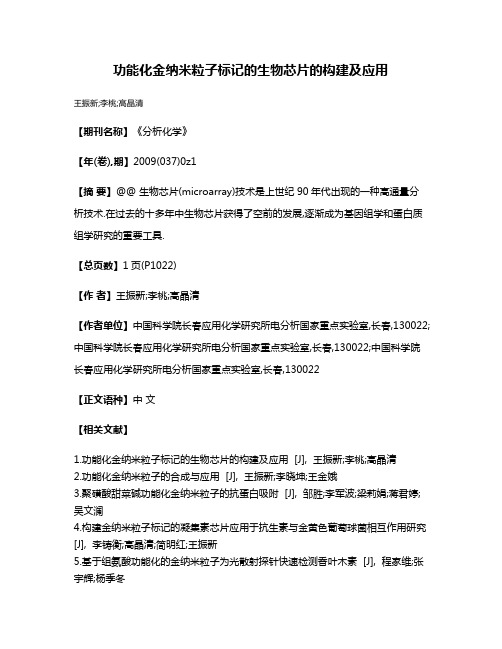
功能化金纳米粒子标记的生物芯片的构建及应用
王振新;李桃;高晶清
【期刊名称】《分析化学》
【年(卷),期】2009(037)0z1
【摘要】@@ 生物芯片(microarray)技术是上世纪90年代出现的一种高通量分析技术.在过去的十多年中生物芯片获得了空前的发展,逐渐成为基因组学和蛋白质组学研究的重要工具.
【总页数】1页(P1022)
【作者】王振新;李桃;高晶清
【作者单位】中国科学院长春应用化学研究所电分析国家重点实验室,长春,130022;中国科学院长春应用化学研究所电分析国家重点实验室,长春,130022;中国科学院长春应用化学研究所电分析国家重点实验室,长春,130022
【正文语种】中文
【相关文献】
1.功能化金纳米粒子标记的生物芯片的构建及应用 [J], 王振新;李桃;高晶清
2.功能化金纳米粒子的合成与应用 [J], 王振新;李晓坤;王金娥
3.聚磺酸甜菜碱功能化金纳米粒子的抗蛋白吸附 [J], 邹胜;李军波;梁莉娟;蒋君婷;吴文澜
4.构建金纳米粒子标记的凝集素芯片应用于抗生素与金黄色葡萄球菌相互作用研究[J], 李铸衡;高晶清;简明红;王振新
5.基于组氨酸功能化的金纳米粒子为光散射探针快速检测香叶木素 [J], 程家维;张宇辉;杨季冬
因版权原因,仅展示原文概要,查看原文内容请购买。
纳米金粒子标记技术在快速蛋白质检测中的应用

纳米金粒子标记技术在快速蛋白质检测中的应用近年来,纳米技术的快速发展为生物医学领域带来了许多新的应用和突破。
其中,纳米金粒子标记技术在快速蛋白质检测中的应用备受关注。
该技术的出现不仅提高了蛋白质检测的准确性和灵敏度,而且具有较快的检测速度和较低的成本。
本文将详细介绍纳米金粒子标记技术在快速蛋白质检测中的原理、应用以及未来的发展前景。
一、纳米金粒子标记技术的原理纳米金粒子是一种具有特殊性质的金属粒子,其尺寸通常在1-100纳米之间。
纳米金粒子标记技术是将这些纳米金粒子与蛋白质分子特异性结合,通过检测纳米金粒子的光学性质实现蛋白质的快速检测。
其原理主要包括两个方面:1. 表面等离激元共振效应:纳米金粒子表面存在自由电子,当受到外界电磁波激发时,这些自由电子会共振震荡,并在金粒子表面产生强烈的电场增强效应,这种现象被称为表面等离激元共振效应。
蛋白质分子的结合会改变纳米金粒子的表面等离激元共振效应,从而改变其光学性质,可通过特定的测量方法实现蛋白质的检测。
2. 富集效应:纳米金粒子具有较大的比表面积和高度多价的性质,使其能够实现蛋白质的高效富集。
当纳米金粒子与蛋白质结合时,纳米金粒子的表面积大幅增加,从而提高了蛋白质的富集效率。
富集后的蛋白质可以通过相关的测量方法进行快速检测。
二、纳米金粒子标记技术在快速蛋白质检测中的应用1. 微量蛋白质测定:传统蛋白质的测定方法需要大量的蛋白质样品,且操作繁琐、耗时长。
而纳米金粒子标记技术可以实现蛋白质的微量测定,只需极少的蛋白质样品即可获得准确的检测结果。
这使得纳米金粒子标记技术在快速蛋白质检测中具有重要的应用价值。
2. 蛋白质相互作用研究:蛋白质相互作用对于生物系统的正常功能至关重要。
纳米金粒子标记技术可以通过标记不同的蛋白质,通过观察其相互作用情况,揭示蛋白质在生物系统中的功能和调控机制。
这对于深入理解生物学过程具有重要的意义。
3. 生物传感器的制备:纳米金粒子标记技术可以将纳米金粒子制备成高灵敏度的生物传感器,用于检测生物样品中特定蛋白质的含量。
小分子g-四链体荧光探针

小分子g-四链体荧光探针小分子g-四链体荧光探针是一种新型的荧光探针,以其高灵敏度、高特异性和易于修饰等优点在生物检测领域受到广泛关注。
本文将详细介绍小分子g-四链体荧光探针的原理、应用以及未来发展前景。
一、小分子g-四链体荧光探针的原理g-四链体是一种具有特殊结构的核酸分子,由两个相互作用的DNA双链组成,形成一个稳定的发夹状结构。
在特定条件下,g-四链体可以猝灭荧光团,从而实现对生物小分子的灵敏检测。
小分子g-四链体荧光探针利用这一原理,通过设计特定的核酸序列,使荧光团与g-四链体结合,从而实现对目标分子的检测。
二、小分子g-四链体荧光探针的应用1.生物传感器:小分子g-四链体荧光探针可作为一种高灵敏度的生物传感器,用于检测各种生物小分子,如金属离子、氨基酸、核苷酸等。
2.疾病诊断:利用小分子g-四链体荧光探针的高特异性,可以用于疾病相关生物标志物的检测,为临床诊断提供便捷、灵敏的方法。
3.环境监测:小分子g-四链体荧光探针可用于环境中有害物质的检测,如重金属、农药等,为环境保护提供技术支持。
4.生物成像:小分子g-四链体荧光探针可以用于活体生物成像,实现对细胞、组织内部结构的实时观察。
三、未来发展前景1.探针优化:通过进一步优化核酸序列设计和荧光团的选择,提高小分子g-四链体荧光探针的灵敏度和特异性,使其在更广泛的生物检测领域得到应用。
2.多功能探针:开发具有多种功能的小分子g-四链体荧光探针,如信号放大、光激活、温度敏感等,以满足不同应用场景的需求。
3.生物传感器的集成:将小分子g-四链体荧光探针与其他生物传感器集成,构建高性能的生物检测平台,实现对多种目标分子的快速、准确检测。
4.临床应用:随着小分子g-四链体荧光探针技术的不断发展,其在临床诊断、治疗监测等方面的应用前景广阔。
总之,小分子g-四链体荧光探针作为一种新型生物检测方法,具有巨大的应用潜力。
通过对探针原理的深入研究和对检测技术的不断创新,小分子g-四链体荧光探针将在生物科学、医学、环境监测等领域发挥重要作用。
2021国外21世纪以来材料领域科技活动的进展范文1

2021国外21世纪以来材料领域科技活动的进展范文材料是人类社会存在和发展的物质基础,是科技创新和技术进步的先导条件,是决定人们行为方式和生活质量的重要力量。
材料在当今世界中的影响和作用越来越强烈,人们把它与信息、能源并称为新技术革命三大支柱之一。
于是,研发材料的新技术,也与信息技术、生物技术等一起,共同构成本世纪世界创新活动潜力最大和最重要的领域。
本世纪以来,国外材料领域的科技研发活动如火如荼,进展迅猛,涌现了大量新成果。
梳理这些新成果,不仅对我国材料领域科技研发有直接参考价值,而且对“中国制造”向“中国智造”转变有重要启迪作用。
本文拟对国外本世纪以来材料领域科技活动的进展情况,作一概述,供有关方面参考。
1研发前沿材料的新进展 1.1.纳米材料 研制精密分子结构、分子多面体结构和单分子等分子级纳米技术,开发由三个分子组成互锁分子的分子级纳米合成技术,研制纳米粒子、纳米球、纳米管、纳米纤维、光控纳米阀、可控的纳米齿轮等纳米产品。
特别是,制成高纯度长碳纳米管、单层碳纳米管、双层碳纳米管、高性能超长碳纳米管等纳米材料,并用碳纳米管制成坚硬材料、纳米元件基础材料、类似壁虎脚底的黏合材料等碳纳米管系列产品。
1.2.石墨烯 自从成功制成石墨烯之后,又相继合成它的“表亲”---二维材料硅烯和二维材料锗烯,还用计算机模拟设计出性能胜过石墨烯的石墨炔;并且已经开发出能够观察石墨烯单个原子一个一个“搭建”晶体的新技术,以及可以大规模批量生产石墨烯的新方法。
目前,已经研制出形状尺寸可控的石墨烯量子点、弯曲如马鞍的石墨烯、高质量石墨烯纳米带等石墨烯产品,同时已用石墨烯制成可伸缩晶体管、柔性电路、高灵敏光电探测器、计算机存储便条,以及纳米二冲程发动机等。
1.3.超材料 1.3.1.超硬材料方面,利用化学气象沉淀法快速制成人造大钻石,利用人造钻石创下量子比特存储时间新纪录,造出可制超强轻质线缆的超细钻石纳米线。
同时,设计出超硬新材料二硼化铼个。
G-四链体荧光生物传感器铅快速分析技术研究进展
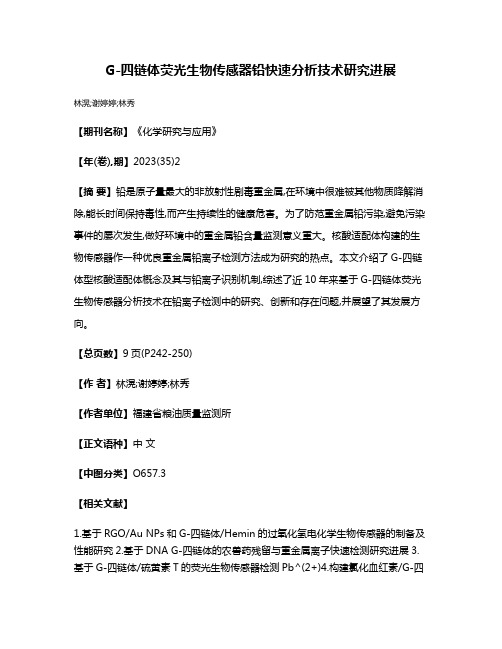
G-四链体荧光生物传感器铅快速分析技术研究进展
林滉;谢婷婷;林秀
【期刊名称】《化学研究与应用》
【年(卷),期】2023(35)2
【摘要】铅是原子量最大的非放射性剧毒重金属,在环境中很难被其他物质降解消除,能长时间保持毒性,而产生持续性的健康危害。
为了防范重金属铅污染,避免污染事件的屡次发生,做好环境中的重金属铅含量监测意义重大。
核酸适配体构建的生物传感器作一种优良重金属铅离子检测方法成为研究的热点。
本文介绍了G-四链体型核酸适配体概念及其与铅离子识别机制,综述了近10年来基于G-四链体荧光生物传感器分析技术在铅离子检测中的研究、创新和存在问题,并展望了其发展方向。
【总页数】9页(P242-250)
【作者】林滉;谢婷婷;林秀
【作者单位】福建省粮油质量监测所
【正文语种】中文
【中图分类】O657.3
【相关文献】
1.基于RGO/Au NPs和G-四链体/Hemin的过氧化氢电化学生物传感器的制备及性能研究
2.基于DNA G-四链体的农兽药残留与重金属离子快速检测研究进展
3.基于G-四链体/硫黄素T的荧光生物传感器检测Pb^(2+)
4.构建氯化血红素/G-四
链体DNA酶比色生物传感器检测食品中苏丹红5.乡村振兴视域下奈曼旗农业绿色发展问题研究
因版权原因,仅展示原文概要,查看原文内容请购买。
纳米材料的生物检测应用

纳米材料的生物检测应用随着现代科技的不断升级,纳米领域正在成为各个领域的研究热点之一。
在生物领域中,纳米材料的应用正成为科学家们关注的焦点。
这些具有特定物理和化学特性的纳米材料可以用于生物检测,从而实现生物相互作用的高灵敏度检测和定量分析。
本文将探讨生物检测领域中纳米材料的应用,包括生物传感器、生物标记物、荧光探针和分子成像技术等。
一、生物传感器生物传感器是一种通过测量生物分子之间的相互作用来检测生物分子的存在的设备。
从化学传感器到免疫传感器,传感器已经成为今天医学诊断和生物研究的重要工具。
与传统方法相比,纳米材料可以更快地检测生物分子的存在,并且允许以更高的分辨率和更低的检出限制进行分析。
例如,碳纳米管(CNT)是一种理想的纳米材料,具有高度的氧化还原活性和电导率,因此在生物传感领域中被广泛应用。
在有机分子检测中,单壁碳纳米管通过与靶分子的化学反应来测量不同溶液中的浓度变化。
碳纳米管的独特特性使其比传统的化学传感器更具有优势,因此在各种生物相关的检测中得到广泛应用。
二、生物标记物生物标记物是指在生物过程中存在的或与生物过程有关的物质。
这些物质可以被用来检测疾病状态、辅助诊断或治疗。
纳米材料是探测生物标记物的理想选择,因为其体积较小,表面积较大,具有高度的灵敏度和特异性。
例如,纳米金颗粒是用于标记生物分子的常用工具。
纳米金颗粒可以通过与生物分子的亲和吸附来标记分子,并且可以通过电子显微镜等成像技术观察它们。
这些纳米颗粒在生物标记物检测和定量方面具有非常广泛的应用,尤其是在DNA分析、蛋白质分析和细胞成像等方面。
三、荧光探针纳米材料在生物成像领域中的应用也十分突出。
荧光探针是被广泛用于生物成像的一种分子,它可以在分子尺度下将信号从分子体系转换为可视化的图像。
由于纳米材料具有高度的表面积和独特的光学性质,因此在荧光探针的应用方面具有非常大的潜力。
例如,量子点是一种纳米尺寸的晶体,它能够发出特定颜色的光并且相对较不敏感。
纳米生物传感器在疾病诊断中的实际应用案例

纳米生物传感器在疾病诊断中的实际应用案例随着纳米技术的发展和生物医学的进步,纳米生物传感器在疾病诊断中得到了广泛应用。
纳米生物传感器能够利用纳米材料的特殊性质,结合生物分子的识别特性,实现对疾病标志物的高灵敏检测,并提供准确的诊断结果。
本文将介绍三个纳米生物传感器在疾病诊断中的实际应用案例,涉及心血管疾病、肿瘤以及感染性疾病的诊断。
第一个应用案例是纳米生物传感器在心血管疾病诊断中的应用。
心血管疾病是全球范围内的主要死因之一,准确快速地检测心血管标志物对于早期诊断和治疗至关重要。
一项研究利用纳米生物传感器成功检测了心力衰竭标志物BNP(B-type natriuretic peptide)。
该传感器利用纳米纤维和纳米金颗粒构建的电化学传感器,通过与标志物相互作用,实现对BNP的高灵敏检测。
研究结果表明,这种纳米生物传感器具有快速响应、高选择性和良好的稳定性,可实现对心血管疾病的早期诊断。
第二个应用案例是纳米生物传感器在肿瘤诊断中的应用。
肿瘤早期诊断对于提高治疗效果具有重要意义。
传统的肿瘤诊断方法往往需要复杂的检测过程和昂贵的设备,而纳米生物传感器则可以提供简便、快速、灵敏的肿瘤诊断方案。
有研究团队利用纳米磁性颗粒制备了一种肿瘤生物标志物CA125的电化学传感器。
这种传感器可以在短时间内实现对CA125的快速检测,并且具有较高的灵敏度和选择性。
研究结果显示,该纳米生物传感器对不同浓度的CA125样品都能产生明显的电流信号变化,为肿瘤的早期诊断提供了一种快捷可靠的方法。
第三个应用案例是纳米生物传感器在感染性疾病诊断中的应用。
感染性疾病的早期诊断对于及时采取治疗措施和控制疫情具有重要意义。
纳米生物传感器在感染疾病的快速检测方面具有巨大潜力。
例如,一项研究报道了一种利用纳米纤维制备的感染性疾病多肽Cathelicidin LL-37的光纤传感器。
该传感器可以快速、灵敏地检测感染性疾病的标志物LL-37,并且可以区分不同浓度的标志物样品。
生物工程的生物传感器

生物工程的生物传感器生物工程的生物传感器是一种利用生物体对特定物质或环境的感知能力,结合现代生物技术和工程技术,用于检测、监测和分析生物体系的一种新兴技术。
它在医学、环境监测、食品安全等领域具有广阔的应用前景。
本文将从生物传感器的原理、分类、应用和发展前景等方面进行详细论述。
一、生物传感器的原理生物传感器的原理是基于生物体的生物识别分子与特定分析物发生作用后,通过信号转导和信号放大的方式,将生物识别分子与目标分析物之间的相互作用转化为可测量的物理或化学信号。
生物传感器的关键在于选择适当的生物识别分子和信号放大机制。
1. 生物识别分子的选择:生物传感器中的生物识别分子通常是生物体自身产生的特异性抗原、酶等,或通过基因工程技术获得的受体、抗体、酶等。
生物传感器的灵敏度和选择性主要依赖于生物识别分子的特异性。
2. 信号放大机制:生物传感器通过信号转导和信号放大的方式将生物识别分子与目标分析物之间的相互作用转化为可测量的信号。
常用的信号放大机制包括荧光、电化学、质谱等。
二、生物传感器的分类根据生物传感器的基本原理和应用方式,可以将其分为多种类型。
主要的分类方法如下:1. 免疫传感器:免疫传感器利用生物识别分子中的抗原与抗体之间的特异性识别作用,实现对特定分析物的检测。
常见的免疫传感器有免疫荧光传感器、表面等离子体共振传感器等。
2. 酶传感器:酶传感器利用酶与底物之间的酶促反应,通过测定底物浓度来检测目标物质。
常见的酶传感器有葡萄糖传感器、乳酸传感器等。
3. DNA传感器:DNA传感器利用DNA的序列特异性识别和杂交反应,实现对DNA片段或基因的检测。
常见的DNA传感器有PCR传感器、荧光原位杂交传感器等。
4. 细胞传感器:细胞传感器利用细胞的特异性反应或信号转导过程,实现对环境中某种物质的检测。
常见的细胞传感器有细胞色素C传感器、细胞表面受体传感器等。
三、生物传感器的应用生物传感器在医学、环境监测、食品安全等领域具有广泛的应用前景。
纳米生物传感器在食品检测中的应用研究

纳米生物传感器在食品检测中的应用研究在当今社会,食品安全问题成为了人们关注的焦点。
传统的食品检测方法耗时耗力,而且准确度有限。
而纳米生物传感器作为一种新型检测方法,具有高灵敏度、高特异性和实时检测等优点。
本文将介绍纳米生物传感器在食品检测中的应用研究及未来发展方向。
一、纳米生物传感器原理和技术纳米生物传感器是利用生物分子与纳米材料之间的相互作用来检测、分析信号的一种技术。
纳米生物传感器的原理是利用生物分子在检测物质存在时发生结构改变,导致电阻、电容、电流、电压等参数发生变化,然后将这种变化转换为信号输出,最后通过计算机分析获得待检测物质的相关信息。
纳米生物传感器的核心部分是纳米材料,包括纳米颗粒、纳米线、纳米管等。
二、纳米生物传感器在食品检测中的应用研究1. 残留农药检测纳米生物传感器在残留农药检测中的应用被广泛关注。
研究人员将金纳米颗粒与酶感受器结合,制成纳米生物传感器,在检测过程中,当有害物质存在时,酶会发生结构变化,进而导致金纳米颗粒聚集、凝集或分散,导致电阻、电容、电流、电压等参数发生变化,最后转换为信号输出,即可检测到残留农药的存在。
2. 检测微生物污染纳米生物传感器可用于检测微生物污染,例如食品中的细菌和病毒。
研究人员制备了芯片型的纳米生物传感器,该传感器可频繁更换生物分子,以适应不同的生物样本和标准,从而实现高灵敏度的微生物检测。
3. 食品中的重金属检测重金属对人体健康具有潜在的威胁,因此食品中的重金属检测至关重要。
利用金纳米颗粒制成的纳米生物传感器可在食品中检测微量重金属。
传感器通过测定金纳米颗粒的表面等离子共振峰位移来检测重金属,具有快速、准确的优点。
三、纳米生物传感器在食品检测中的未来发展方向1. 基于智能手机的检测设备基于智能手机的检测设备是一种新的纳米生物传感器开发方向。
研究人员正在利用智能手机的成像和计算功能,制备易于使用和便携的食品检测设备。
这种设备将极大地降低检测成本,提高检测效率,使人们更容易检测食品安全问题。
纳米金粒子在生物传感器中的使用方法
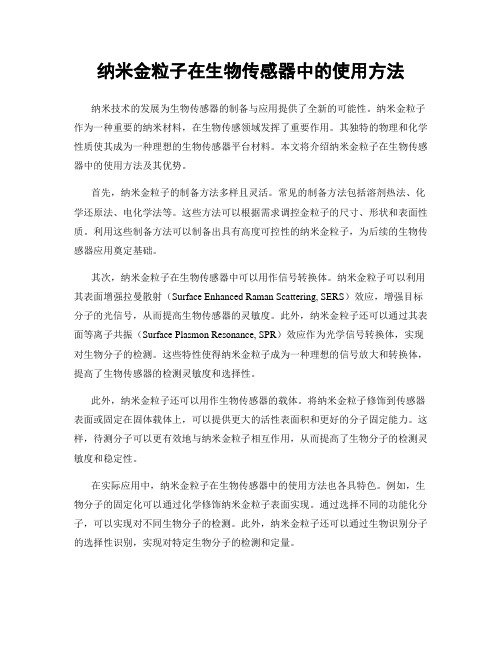
纳米金粒子在生物传感器中的使用方法纳米技术的发展为生物传感器的制备与应用提供了全新的可能性。
纳米金粒子作为一种重要的纳米材料,在生物传感领域发挥了重要作用。
其独特的物理和化学性质使其成为一种理想的生物传感器平台材料。
本文将介绍纳米金粒子在生物传感器中的使用方法及其优势。
首先,纳米金粒子的制备方法多样且灵活。
常见的制备方法包括溶剂热法、化学还原法、电化学法等。
这些方法可以根据需求调控金粒子的尺寸、形状和表面性质。
利用这些制备方法可以制备出具有高度可控性的纳米金粒子,为后续的生物传感器应用奠定基础。
其次,纳米金粒子在生物传感器中可以用作信号转换体。
纳米金粒子可以利用其表面增强拉曼散射(Surface Enhanced Raman Scattering, SERS)效应,增强目标分子的光信号,从而提高生物传感器的灵敏度。
此外,纳米金粒子还可以通过其表面等离子共振(Surface Plasmon Resonance, SPR)效应作为光学信号转换体,实现对生物分子的检测。
这些特性使得纳米金粒子成为一种理想的信号放大和转换体,提高了生物传感器的检测灵敏度和选择性。
此外,纳米金粒子还可以用作生物传感器的载体。
将纳米金粒子修饰到传感器表面或固定在固体载体上,可以提供更大的活性表面积和更好的分子固定能力。
这样,待测分子可以更有效地与纳米金粒子相互作用,从而提高了生物分子的检测灵敏度和稳定性。
在实际应用中,纳米金粒子在生物传感器中的使用方法也各具特色。
例如,生物分子的固定化可以通过化学修饰纳米金粒子表面实现。
通过选择不同的功能化分子,可以实现对不同生物分子的检测。
此外,纳米金粒子还可以通过生物识别分子的选择性识别,实现对特定生物分子的检测和定量。
对于传统的生物传感器,纳米金粒子的应用也可以带来很多进展。
例如,纳米金粒子的引入可以提高传统电化学传感器的灵敏度和稳定性。
纳米金粒子的应用还可以提供新的检测机制,使得生物分子的分析更加快速和准确。
纳米生物传感器在食品安全检测中的应用

纳米生物传感器在食品安全检测中的应用近年来,随着科技的不断发展,纳米技术在各领域的应用逐渐增多,其中纳米生物传感器在食品安全检测中的应用引人瞩目。
纳米生物传感器作为一种高效、灵敏的检测技术,具有广阔的应用前景。
本文将重点介绍纳米生物传感器在食品安全检测中的应用及其优势。
一、纳米生物传感器的构成和原理纳米生物传感器由纳米材料和生物分子组成,具有较大的比表面积和高度的灵敏度。
其结构包括纳米电极、纳米薄膜和生物分子层。
纳米电极是传感器的核心部分,通过与目标物质的特异性反应,实现信号的传递和转化。
生物分子层由酶、抗体等生物材料构成,用于与目标物质的结合,提高传感器的选择性和灵敏度。
二、纳米生物传感器在食品安全检测中的应用1. 快速检测食品中的有害物质纳米生物传感器能够快速检测食品中的有害物质,如重金属、农药残留等。
传统的检测方法通常需要复杂的仪器和操作流程,而纳米生物传感器可以通过简单、快速的操作,实时监测食品中的有害物质,并提供准确的结果,大大提高了检测的效率和准确性。
2. 鉴别食品中的假冒伪劣产品通过使用纳米生物传感器,可以对食品中的成分进行快速准确的鉴别,从而有效防止假冒伪劣产品的流通。
纳米生物传感器能够识别食品中特定成分的存在与否,准确判断食品的真伪,保障消费者的权益。
3. 检测食品中的微生物污染纳米生物传感器在食品安全检测中还可以用于检测食品中的微生物污染,如细菌、病毒等。
通过对食品样本中的微生物进行特异性识别和快速筛查,可以及时发现并及时控制食品中的微生物污染,保障食品的安全性和卫生质量。
三、纳米生物传感器在食品安全检测中的优势1. 高灵敏度和选择性纳米生物传感器具有较大的比表面积,能够提高与目标物质的接触面积,增强与目标物质的特异性相互作用,从而提高检测的灵敏度和选择性。
2. 快速检测纳米生物传感器具有快速检测的特点,通过简单的操作和有效的信号转化,可以在短时间内得到准确的检测结果。
3. 实时监测纳米生物传感器可以实时监测食品中的有害物质和微生物污染,及时发现潜在的食品安全问题,有助于保障公众健康。
一种用于检测β-乳球蛋白的双功能G-四链体变构生物传感器[发明专利]
![一种用于检测β-乳球蛋白的双功能G-四链体变构生物传感器[发明专利]](https://img.taocdn.com/s3/m/145b20ce112de2bd960590c69ec3d5bbfd0adac1.png)
专利名称:一种用于检测β-乳球蛋白的双功能G-四链体变构生物传感器
专利类型:发明专利
发明人:许文涛,田洪涛,王鑫昕,陈可仁,朱龙佼,杜再慧,田晶晶
申请号:CN202210057605.9
申请日:20220119
公开号:CN114075565B
公开日:
20220419
专利内容由知识产权出版社提供
摘要:本发明公开了一种用于检测β‑乳球蛋白的双功能G‑四链体变构生物传感器,包括:(1)β‑乳球蛋白双功能G‑四链体适配体设计;(2)β‑乳球蛋白生物传感器反应条件优化;
(3)β‑乳球蛋白的检测。
设计原理是基于β‑乳球蛋白生物传感器序列在引入检测靶标前后发生构象变化,对G‑四链体/氯化血红素(Hemin)DNA仿生酶的过氧化氢酶活产生影响,进而实现β‑乳球蛋白的检测。
G‑四链体序列响应靶标浓度,使得其催化3,3',5,5'‑四甲基联苯胺(TMB)显色后溶液呈现出相应的比色梯度,最终实现了β‑乳球蛋白简便、快速、低成本、超灵敏的比色检测。
申请人:中国农业大学
地址:100083 北京市海淀区圆明园西路2号
国籍:CN
代理机构:北京领科知识产权代理事务所(特殊普通合伙)
代理人:张丹
更多信息请下载全文后查看。
核酸功能化 金纳米粒子

核酸功能化金纳米粒子
核酸功能化金纳米粒子是指将金纳米粒子表面修饰上特定的核酸分子,以赋予金纳米粒子特定的生物学功能和化学性质。
这种功能化可以赋予金纳米粒子在生物医学领域、生物传感器和药物输送系统等方面的广泛应用。
首先,我们来谈谈核酸功能化金纳米粒子在生物医学领域的应用。
由于核酸功能化金纳米粒子具有良好的生物相容性和生物可降解性,它们可以作为生物标记物、药物载体和生物成像剂在癌症治疗和诊断中发挥重要作用。
通过改变核酸的序列和结构,可以实现对癌细胞的靶向识别和治疗,从而提高治疗效果和减少毒副作用。
其次,核酸功能化金纳米粒子在生物传感器方面也具有重要意义。
由于核酸具有特异的配对和识别能力,功能化金纳米粒子可以用于检测特定的DNA或RNA序列,从而实现基因检测、病毒检测和基因组学研究等方面的应用。
这种生物传感器具有高灵敏度和高特异性,对于临床诊断和生物分析具有重要意义。
此外,核酸功能化金纳米粒子还可以用作药物输送系统。
通过改变核酸的结构和功能,可以实现对药物的载体和释放控制,从而
提高药物的生物利用度和靶向性,减少药物的毒副作用。
这种药物输送系统对于肿瘤治疗和基因治疗具有重要意义,可以有效提高药物的治疗效果。
综上所述,核酸功能化金纳米粒子在生物医学领域具有广泛的应用前景,可以为癌症治疗、生物传感器和药物输送系统等方面带来重要的创新和突破。
随着生物技术和纳米技术的不断发展,相信这一领域的研究会取得更多的进展,为人类健康和生命科学领域带来更多的福祉。
- 1、下载文档前请自行甄别文档内容的完整性,平台不提供额外的编辑、内容补充、找答案等附加服务。
- 2、"仅部分预览"的文档,不可在线预览部分如存在完整性等问题,可反馈申请退款(可完整预览的文档不适用该条件!)。
- 3、如文档侵犯您的权益,请联系客服反馈,我们会尽快为您处理(人工客服工作时间:9:00-18:30)。
Sensors and Actuators B 212(2015)440–445Contents lists available at ScienceDirectSensors and Actuators B:Chemicalj o u r n a l h o m e p a g e :w w w.e l s e v i e r.c o m /l o c a t e /s nbVisual detection of myoglobin via G-quadruplex DNAzymefunctionalized gold nanoparticles-based colorimetric biosensorQing Wang,Xiaohan Yang,Xiaohai Yang ∗,Fang Liu,Kemin Wang ∗State Key Laboratory of Chemo/Biosensing and Chemometrics,College of Chemistry and Chemical Engineering,Key Laboratory for Bio-Nanotechnology and Molecular Engineering of Hunan Province,Hunan University,Changsha 410082,Chinaa r t i c l ei n f oArticle history:Received 19December 2014Received in revised form 7February 2015Accepted 10February 2015Available online 18February 2015Keywords:Gold nanoparticles DNAzyme Aptamer Myoglobina b s t r a c tSince myoglobin plays a major role in the diagnosis of acute myocardial infarction (AMI),monitoring of myoglobin in point-of-care is fundamental.Here,a novel colorimetric assay for myoglobin detection was developed based on hemin/G-quadruplex DNAzyme functionalized gold nanoparticles (AuNPs).In the presence of myoglobin,the anti-myoglobin antibody,which was modified on the surface of polystyrene microplate,could first capture the target myoglobin.Then the captured target could further bind to DNA1probe which contained the aptamer sequence through aptamers/myoglobin interaction.Next,as the DNA2probe modified AuNPs were introduced,DNA2probe modified AuNPs could hybridize with the captured DNA1probe.Subsequently,DNA2probe which was modified on the AuNPs could fold into a G-quadruplex structure and bind to hemin,and then catalyze the oxidation of colorless ABTS 2−to green ABTS +by H 2O 2.Consequently,the relationship between the concentration of myoglobin and the absorbance was established.Due to AuNPs amplification,the myoglobin concentration as low as 2.5nM could be detected,which was lower than clinical cutoff for myoglobin in healthy patients.This assay also showed high selectivity for myoglobin and was used for the detection of myoglobin in the human serum samples.This work may provide a simple but effective tool for early diagnosis of AMI in the world,especially in developing countries.©2015Elsevier B.V.All rights reserved.1.IntroductionSince acute myocardial infarction (AMI)remains the leading cause of death in most industrialized nations,it is important to evaluate accurately the patients who show symptoms sugges-tive of AMI [1,2].Myoglobin,although not cardiac specific,has been widely suggested as one of the best candidate markers for an early diagnosis of AMI [3].Generally,myoglobin is present in very low concentrations (0.48–5.9nM)in serum of healthy indi-viduals.When muscle tissues are damaged,myoglobin is rapidly released into the circulation and the myoglobin concentration in serum is elevated to 4.8M subsequently [4].Some conventional approaches have been employed to detect myoglobin,such as mass spectrometry [5],liquid chromatography [6],electrochemi-cal [7–11]and surface plasmon resonance (SPR)[12–15].Most of these methods showed high sensitivity,but these methods were time consuming and required expensive equipment,which was unable to be applied in point-of-care (POC)testing [16].Recently,∗Corresponding authors.Tel.:+8673188821566;fax:+8673188821566.E-mail addresses:yangxiaohai@ (X.Yang),kmwang@ (K.Wang).we reported a novel assay for sensitive and selective detection of myoglobin using a personal glucose meter [17].Besides glucose meter,colorimetric method offers great potential for POC testing,due to its intrinsic advantages such as cost-effective,rapid,simple,and even only utilizing naked eyes.Zhang et al.reported a colori-metric method for myoglobin detection based on the aggregation of iminodiacetic acid-functionalized gold nanoparticles (AuNPs)[18].Although this method was easy to perform,low cost and time-saving,the detection limit is relatively high.Here,a novel colorimetric method was developed for myoglobin detection based on hemin/G-quadruplex DNAzyme functional-ized AuNPs.G-quadruplex DNAzyme,which is usually formed by binding G-rich nucleic acid to hemin [19–21],can exhibit peroxidase-like activity and effectively catalyze the H 2O 2-mediated oxidation of 2,2 -azino-bis (3-ethylbenzothiazoline-6-sulfonic acid)diammonium salt (ABTS)[22–24].In this assay,hemin/G-quadruplex DNAzyme complex showed inherent advan-tages of simplicity,stability and relatively low cost.Moreover,since a single Au nanoparticle was loaded with hundreds of DNA2probes which contained DNAzyme section [25,26],it could enhance the sensitivity effectively.This work may provide the new tool for early diagnosis of AMI in the world,especially in developing countries./10.1016/j.snb.2015.02.0400925-4005/©2015Elsevier B.V.All rights reserved.Q.Wang et al./Sensors and Actuators B212(2015)440–445441Fig.1.Schematic illustration of myoglobin detection using hemin/G-quadruplex DNAzyme functionalized AuNPs.2.Experimental2.1.Materials and reagentsMyoglobin(from human heart tissue)and monoclonal anti-myoglobin antibody were purchased from Abcam(USA).C reactive protein(CRP)was purchased from Biovision(USA).Bovine serum albumin(BSA),human serum albumin(HSA)and human immunoglobulin G(IgG)were purchased from Beijing Dingguo Changsheng Biotechnology Co.,Ltd.(China).Hemin and ABTS were purchased from Sigma-Aldrich(USA).DNA1probe(5 -CCC TCC TTT CCT TCG ACG TAG ATC TGC TGC GTT GTT CCG ATT TTT AGA TGG CTA TGC AA-3 )[27]and DNA2probe(5 -T17GGG TAG GGC GGG TTG GGT10TTG CAT AGC CAT CT-3 )were synthesized by Sangon Biotech.(Shanghai)Co.,Ltd.The former contained the myoglobin aptamer sequence and the latter contained the DNAzyme section. All of the chemical reagents were of analytical grade or higher. Amicon ultra centrifugalfilter(30K)was purchased from Milli-pore Corporation(USA).Ultrapure water(18.2M cm)was used throughout.2.2.Preparation and modification of AuNPsAuNPs(∼13nm)were synthesized by the trisodium citrate reduction of HAuCl4[28].DNA2probe modified AuNPs were obtained as previously reported[29].Briefly,3.6M concentra-tion of DNA2probe was incubated with AuNPs solution for16h at4◦C.Then,the above mixture was aged for40h under0.1M NaCl solution(pH7.0,0.01M PBS buffer).Next,such solution was centrifuged(30min,13,500×g)and the red oily precipitate was washed with0.1M NaCl solution(pH7.0,0.01M PBS buffer). After a second centrifugation,the red oily precipitate was dis-persed in0.3M NaCl solution(pH7.0,0.01M PBS buffer)and DNA2probe modified AuNPs was obtained.Absorption spectra of AuNPs and DNA2probe modified AuNPs were recorded on a UV-1601spectrophotometer(Shimadzu,Japan)at room temper-ature.The maximum UV–visible absorption peak of AuNPs and DNA2probe modified AuNPs in solution were518.0and524.0nm, respectively.According to the previous work[30],it was calcu-lated that the concentration of DNA2probe modified AuNPs was ca.2.9nM.2.3.Immobilization of antibody on the microplateAnti-myoglobin antibody was bound non-covalently to the polystyrene microplate as previously reported[17].In brief,anti-myoglobin antibody(0.5g/ml)was incubated the polystyrene microplate for12h at4◦C in a humid chamber.After the microplate was rinsed thoroughly,it was incubated in1%BSA for1h to decrease non-specific binding.Next,the microplate was washed repeatedly,and it was ready for use.2.4.Procedures of myoglobin detectionDifferent concentration of myoglobin solution was incubated in anti-myoglobin antibody modified microplate for60min at37◦C, followed by a thorough rinsing with10mM PBS buffer(pH7.4). Then,DNA2probe modified AuNPs and a concentration of200nM of DNA1probe were added.After60min of incubation at37◦C,the microplate was thoroughly rinsed with10mM PBS buffer.Next,0.5M hemin was added and incubated for60min,followed bya thorough rinsing with10mM PBS buffer.After incubation with 6mM ABTS and3mM H2O2for5min at25◦C,absorption spectra of the reaction solution were measured.For identifying the target-specificity of this assay,three pro-teins,i.e.IgG,HSA and CRP,were respectively reacted with anti-myoglobin which was immobilized on the microplate for 60min at room temperature,followed by a thorough washing with10mM PBS.Then,the DNA2probe modified AuNPs and a concentration of200nM of DNA1probe were added and incu-bated for60min,and then the microplate was rinsed repeatedly with10mM PBS.Next,0.5M hemin was reacted for60min, followed by a thorough rinsing with10mM PBS buffer.Finally, after6mM ABTS and3mM H2O2were reacted for5min at25◦C, the reaction solution was recoded using UV–visible absorption spectrometer.3.Results and discussion3.1.Principle of colorimetric biosensor for myoglobin detectionThe principle of this novel assay is shown in Fig.1.Anti-myoglobin antibody,which was non-covalently immobilized on microplate,wasfirst used to capture target myoglobin.As the442Q.Wang et al./Sensors and Actuators B212(2015)440–445Fig.2.Effect of(A)K+ion concentration,(B)H2O2concentration,(C)pH value,(D)temperature and(E)the incubation time on the absorbance of the solution.When one parameter changed and the others were under their optimal conditions.The optimal conditions:K+ion concentration:20mM;H2O2concentration:3mM;pH:8.0; temperature:25◦C;the incubation time:5min.The concentration of myoglobin was500nM here.The error bars represent the standard deviation of three measurements.DNA1probe which contained aptamer sequence was introduced, it could be captured on the microplate since the aptamer against myoglobin and anti-myoglobin antibody can bind to myoglobin synchronously[17].Upon the addition of DNA2probe modified AuNPs,the bound DNA1probe could further capture DNA2probe modified AuNPs due to DNA hybridization.Next,DNA2probe which modified AuNPs could fold into a G-quadruplex structure for hemin binding,and then catalyze the H2O2-mediated oxidation of ABTS to release the colored radical product(i.e.ABTS radical cation (ABTS+)),resulting in an obvious color change.This reaction pro-cess could be monitored with a UV-spectrophotometer.According to the relationship between absorption change and the myoglobin concentration,myoglobin could be detected using this simple and sensitive method.Q.Wang et al./Sensors and Actuators B212(2015)440–445443Fig.3.(A)Distinguishable color changes of different concentrations of myoglobin;from right to left,the concentration of myoglobin changed from0to1000nM.(B)Absorption spectra for different concentrations of myoglobin detection.(C)The relationship between the myoglobin concentration and the absorbance enhancement(A1–A0).A0was the absorbance at418nm in the absence of target,while A1was the absorbance at418nm in the presence of target.The insert was the calibration plot for myoglobin.The error bars represented the standard deviation of the three measurements.(D)The change of absorbance for myoglobin and other proteins.3.2.Optimization of the experimental conditionsFor improving the sensitivity,some factors,such as pH,tem-perature,the concentration of K+ion and H2O2,the incubation time between anti-myoglobin antibody and target myoglobin,were optimized.Since it was reported that K+ion can act as coordination cation to stabilize the G-quadruplex structure,the effect of the concen-tration of K+ion was investigated over the range from0to25mM. As shown in Fig.2A,the absorbance increased obviously with the concentration of K+ion and reached a plateau at the concentration of20mM.Thus,a concentration of20mM of K+ion was selected.The concentration of H2O2played an important role in this assay,so the concentration of H2O2was also optimized.As shown in Fig.2B,as the H2O2concentration increased to3mM,the absorbance reached the maximum;while a decrease was observed at higher H2O2concentrations.As the concentration of H2O2was low,the low amount of green product was obtained,resulting in the low signal intensity.As the concentration of H2O2increased, the high signal could be obtained.However,the blank response also increased,resulting in the low absorbance difference.Hence,3mM H2O2was selected as the optimum H2O2concentration here.pH value can influence not only the formation of G-quadruplex,but also the catalytic activity of DNAzyme,so the effect of pH value was also investigated.As shown in Fig.2C,the absorbance increased with the pH as the pH value ranged from4.0to8.0;while a decrease was observed as pH value increased from8.0to10.0.Therefore,pH 8.0was selected as the optimum pH environment.In view that both DNAzyme construct and its enzyme activity were influenced obviously by the reaction temperature,the tem-perature was also investigated.As shown in Fig.2D,when the temperature was either lower or higher than25◦C,the absorbance444Q.Wang et al./Sensors and Actuators B212(2015)440–445signal obviously decreased.Thus,25◦C was chosen as the reaction temperature.Since the reaction was initiated by hemin/DNAzyme complex to the mixture of ABTS and H2O2,the effect of incubation time with the mixture of ABTS and H2O2was also investigated.As shown in Fig.2E,the absorbance signal shifted obviously as the incubation time increased,and then became saturated at5min.Hence,5min was selected as the incubation time with the mixture of ABTS and H2O2.3.3.Detection of myoglobinDifferent concentrations of myoglobin were detected at the fol-lowing experimental conditions:the concentration of K+ion,the concentration of H2O2,pH,temperature,and the incubation time was20mM,3mM,8.0,25◦C and5min,respectively.As shown in Fig.3A,the color of the solution was gradually turned into green as the amount of myoglobin increased,and even20nM myoglobin could be discriminated by the naked eye.As the concentration of myoglobin increased,the amount of DNA2probe modified AuNPs which was captured also increased,resulting in the increase of DNAzyme/hemin complex.Subsequently,the green product which was produced in the solution as ABTS and H2O2were added,result-ing in an obvious color change.The UV–vis spectra of the solution in the presence of different concentrations of myoglobin are depicted in Fig.3B.Obviously,as the target myoglobin was present,there appeared a clear absorption peak at418nm.Along with the increas-ing of the concentration of myoglobin,the absorbance at418nm correspondingly increased.The absorbance enhancement(A1–A0) of the solution versus the myoglobin concentration was employed to quantitatively detect myoglobin,and an acceptable standard deviation was obtained from three repeated experiments.A1was the absorbance of the solution at418nm in the presence of myo-globin,while A0was the absorbance of the solution at418nm in the absence of myoglobin.As shown in Fig.3C,the absorbance enhance-ment increased with the increase of myoglobin concentration.Inset showed a linear dependence of the absorbance enhancement on the myoglobin quantity in the range of2.5–100nM.According to the3ırule,the detection limit of this method was estimated to be 2.5nM,which was below the clinical cutoff myoglobin concentra-tion of5.4nM for healthy patients[14].Moreover,this sensitive was comparable to or better than that of those previous work [10,11,14,16,18].Besides sensitivity,the selectivity of this assay was also investi-gated.Three proteins,i.e.IgG,HSA and CRP,were used as contrasts. As shown in Fig.3D,the presence of myoglobin led to remarkable increase of the absorbance,while very low absorbance could be detected in the presence of other three proteins.It implied that this assay showed high selectivity for myoglobin detection.The excellent selectivity of this assay may be ascribed to the high speci-ficity of the anti-myoglobin antibody/myoglobin interaction and aptamer/myoglobin interaction.This method was also used to detect myoglobin in human serum.Here,three human serum samples which was obtained from hospital were detected using Automated Chemistry Analyzer and this method,respectively.For this method,human serum sam-ples werefirstfiltered using centrifugalfiltration devices(30K) to remove macromolecules,e.g.HSA and other abundant proteins. Then the treated human serum samples were analyzed.The results obtained are presented in paring with the results measured using Automated Chemistry Analyzer,it was easy to find that the results obtained by our proposed method showed good accordance with that of commercial analyzer.The results demonstrated its potentials for practical applications in disease diagnostics.Table1Detection of myoglobin in human serum samples.Myoglobin detection usingAutomated Chemistry Analyzer(nM)Myoglobin detection usingthis assay(nM)(n=3)Sample153.549.8±3.2Sample2114.8115.7±7.3Sample3184.2176.3±9.14.ConclusionIn conclusion,a novel and sensitive colorimetric assay was developed for myoglobin detection based on AuNPs and G-quadruplex DNAzyme.This method did not require any expensive instruments(only using UV–vis spectrophotometer).Due to the AuNPs amplification,this assay showed excellent sensitivity.More-over,this simple and sensitive assay could be used for myoglobin detection in human serum samples,implying that it has great potential application in clinical biological analysis,especially in developing countries.Theoretically,this assay could potentially be used for the detection of other targets which can bind to the aptamer and antibody(or aptamer)synchronously,such as adeno-sine,thrombin and cell.For prospective development,there are at least two attempts underway.One is validation of assay performance for quantitative purposes,including accuracy,precision,etc.The other is to inte-grate the sample treatment process with this assay based on the microfluidics.AcknowledgmentsThis work was supported by the National Natural Science Foundation of China(21190040,21375034,21175035),National Basic Research Program(2011CB911002),International Science& Technology Cooperation Program of China(2010DFB30300),the Fundamental Research Funds for the Central Universities and the China Scholarship council(201308430175).References[1]WHO,Health Topics,Cardiovascular Diseases,World Health Organization,www.who.int/topics/cardiovasculardiseases/en(accessed on April,2011). [2]J.Zhu,N.Zou,H.Mao,P.Wang,D.Zhu,H.Ji,H.Cong,C.Sun,H.Wang,F.Zhang,J.Qian,Q.Jin,J.Zhao,Evaluation of a modified lateralflow immunoas-say for detection of high-sensitivity cardiac troponin I and myoglobin,Biosens.Bioelectron.42(2013)522–525.[3]S.J.Aldous,Cardiac biomarkers in acute myocardial infarction,Int.J.Cardiol.164(2013)282–294.[4]A.H.B.Wu,ios,S.Green,T.G.Gornet,S.S.Wong,L.Parmley,A.S.Tonnesen,B.Plaisier,R.Orlando,Immunoassays for serum and urine myoglobin:myoglobin clearance assessed as a risk factor for acute renal failure,Clin.Chem.40(1994) 796–802.[5]B.M.Naveena,C.Faustman,N.Tatiyaborworntham,S.Yin,R.Ramanathan,R.A.Mancini,Detection of4-hydroxy-2-nonenal adducts of turkey and chicken myoglobins using mass spectrometry,Food Chem.122(2010)836–840.[6]N.Giaretta,A.M.A.D.Giuseppe,M.Lippert,A.Parente,A.D.Maro,Myoglobin asmarker in meat adulteration:a UPLC method for determining the presence of pork meat in raw beef burger,Food Chem.141(2013)1814–1820.[7]I.Lee,X.Luo,X.T.Cui,M.Yun,Highly sensitive single polyaniline nanowirebiosensor for the detection of immunoglobulin G and myoglobin,Biosens.Bio-electron.26(2011)3297–3302.[8]S.S.Mandal,K.K.Narayan,A.J.Bhattacharyya,Employing denaturation for rapidelectrochemical detection of myoglobin using TiO2nanotubes,J.Mater.Chem.B1(2013)3051–3056.[9]S.K.Mishra,D.Kumar,A.M.Biradar,Rajesh,Electrochemical impedance spec-troscopy characterization of mercaptopropionicacid capped ZnS nanocrystal based bioelectrode for the detection of thecardiac biomarker-myoglobin,Bio-electrochemistry88(2012)118–126.[10]F.T.C.Moreira,R.A.F.Dutra,J.P.C.Noronha,M.G.F.Sales,Electrochemical biosen-sor based on biomimetic material for myoglobin detection,Electrochim.Acta 107(2013)481–487.[11]F.T.C.Moreira,S.Sharma,R.A.F.Dutra,J.P.C.Noronha,A.E.G.Cass,M.G.F.Sales,Smart plastic antibody material(SPAM)tailored on disposable screen printedQ.Wang et al./Sensors and Actuators B212(2015)440–445445electrodes for protein recognition:application to myoglobin detection,Biosens.Bioelectron.45(2013)237–244.[12]O.V.Gnedenko,Y.V.Mezentsev, A.A.Molnar, A.V.Lisitsa, A.S.Ivanov, A.I.Archakov,Highly sensitive detection of human cardiac myoglobin using a reverse sandwich immunoassay with a gold nanoparticle-enhanced surface plasmon resonance biosensor,Anal.Chim.Acta759(2013)105–109.[13]J.F.Masson,T.M.Battaglia,P.Khairallah,S.Beaudoin,K.S.Booksh,Quantitativemeasurement of cardiac markers in undiluted serum,Anal.Chem.79(2007) 612–619.[14]E.Matveeva,Z.Gryczynski,I.Gryczynski,J.Malicka,kowicz,Myoglobinimmunoassay utilizing directional surface plasmon-coupled emission,Anal.Chem.76(2004)6287–6292.[15]B.Osman,L.Uzun,N.Bes¸irli,A.Denizli,Microcontact imprinted surface plas-mon resonance sensor for myoglobin detection,Mater.Sci.Eng.C33(2013) 3609–3614.[16]F.T.C.Moreira,R.A.F.Dutra,J.P.C.Noronha,M.G.F.Sales,Myoglobin-biomimeticelectroactive materials made by surface molecular imprinting on silica beads and their use as ionophores in polymeric membranes for potentiometric trans-duction,Biosens.Bioelectron.26(2011)4760–4766.[17]Q.Wang,F.Liu,X.Yang,K.Wang,H.Wang,X.Deng,Sensitive point-of-caremonitoring of cardiac biomarker myoglobin using aptamer and ubiquitous personal glucose meter,Biosens.Bioelectron.64(2015)161–164.[18]X.Zhang,X.Kong,W.Fan,X.Du,Iminodiacetic acid-functionalized goldnanoparticles for optical sensing of myoglobin via Cu2+coordination,Langmuir 27(2011)6504–6510.[19]N.Omar,Q.Loh,G.J.Tye,Y.S.Choong,R.Noordin,J.Glökler,T.S.Lim,Develop-ment of an antigen-DNAzyme based probe for a direct antibody-antigen assay using the intrinsic DNAzyme activity of a daunomycin aptamer,Sensors14 (2014)346–355.[20]R.Li,C.Xiong,Z.Xiao,L.Ling,Colorimetric detection of cholesterol with G-quadruplex-based DNAzymes and ABTS2-,Anal.Chim.Acta724(2012)80–85.[21]Y.Hao,Q.Guo,H.Wu,L.Guo,L.Zhong,J.Wang,T.Lin,F.Fu,G.Chen,Amplifiedcolorimetric detection of mercuric ions through autonomous assembly of G-quadruplex DNAzyme nanowires,Biosens.Bioelectron.52(2014)261–264. [22]J.L.Huppert,Structure,location and interactions of G-quadruplexes,FEBS J.277(2010)3452–3458.[23]H.J.Lipps,D.Rhodes,G-quadruplex structures:in vivo evidence and function,Trends Cell Biol.19(2009)414–422.[24]P.Travascio,Y.Li,D.Sen,DNA-enhanced peroxidase activity of a DNA aptamer-hemin complex,Chem.Biol.5(1998)505–517.[25]T.Niazov,V.Pavlov,Y.Xiao,R.Gill,I.Willner,DNAzyme-functionalized Aunanoparticles for the amplified detection of DNA or telomerase activity,Nano Lett.4(2004)1683–1687.[26]R.Z.Fu,T.H.Li,H.G.Park,An ultrasensitive DNAzyme-based colorimetric strat-egy for nucleic acid detection,mun.39(2009)5838–5840.[27]Q.Wang,W.Liu,Y.Xing,X.Yang,K.Wang,R.Jiang,P.Wang,Q.Zhao,Screeningof DNA aptamers against myoglobin using a positive and negative selection units integrated microfluidic chip and its biosensing application,Anal.Chem.86(2014)6572–6579.[28]G.Frens,Controlled nucleation for the regulation of the particle size inmonodisperse gold suspensions,Nat.Phys.Sci.241(1973)20–22.[29]Q.Wang,L.Yang,X.Yang,K.Wang,L.He,J.Zhu,Electrochemical biosen-sors for detection of point mutation based on surface ligation reaction and oligonucleotides modified gold nanoparticles,Anal.Chim.Acta688(2011) 163–167.[30]R.Jin,G.Wu,Z.Li,C.A.Mirkin,G.C.Schatz,What controls the melting proper-ties of DNA-linked gold nanoparticle assemblies?J.Am.Chem.Soc.125(2003) 1643–1654.BiographiesQing Wang has received her Ph.D.in analytical chemistry at Hunan University in 2007with a thesis on biosensors.Now she is an associated professor of chemistry in Hunan University.Her research interests are in thefield of optical sensors and biosensors.Xiaohan Yang is a graduated M.S.student at Hunan University.Her research inter-ests include colorimetric assay based gold nanoparticle and DNAzyme.Xiaohai Yang has received his Ph.D.in analytical chemistry at Hunan University in 2000and carried on post-doctor study in University of Tokyo from2002to2004. He is a professor of chemistry in Hunan University.His research interests are in the field of optical biosensing on nanometer and single molecule level.Fang Liu is a graduated M.S.student at Hunan University.Her research interest is mainly focused on the development and application of portable sensor.Kemin Wang is a professor of chemistry and biomedical engineering of Hunan Uni-versity since1992.He obtained a Ph.D.degree in analytical chemistry at Hunan University in1987and carried on post-doctor study in Union High Institute of Tech-nology of Zurich in Switzerland from1989to1991.His research interests mainly concentrate biological analytical chemistry on nanometer and single molecule level, such as nanometer biotechnology,nanometer biomedical device,chemistry and biological sensing technology,etc.。
